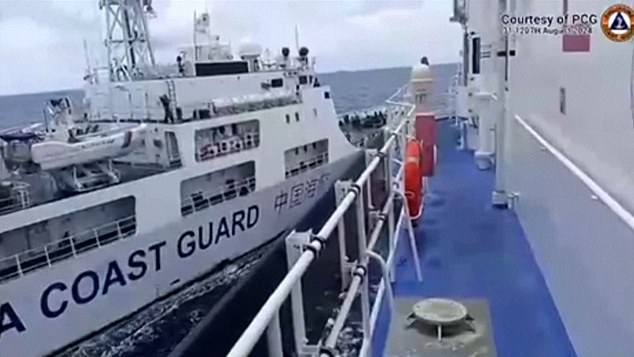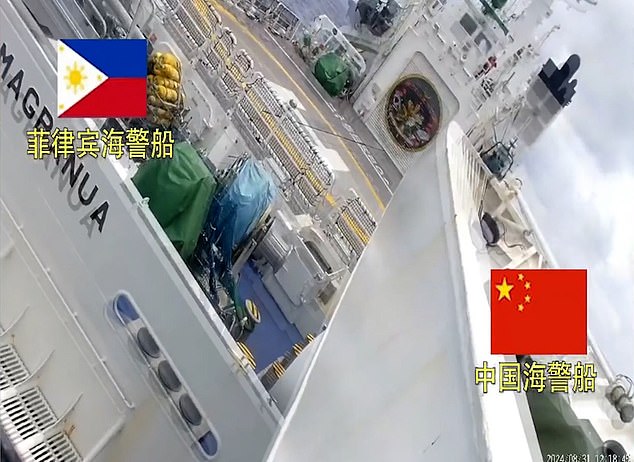This is the shocking moment Chinese and Philippine coast guard ships collide in the latest standoff over disputed waters, as both countries blame each other for the ocean clash.
The Chinese coast guard has sharply criticised the Philippine ship, saying it had manoeuvred and “deliberately collided” with its vessel “in an unprofessional and dangerous manner”.
But Philippine officials in Manila said it was their coast guard ship, the BRP Teresa Magbanua, that was rammed three times by the Chinese coast guard without any provocation, causing damage to the Philippine vessel.
It is the second incident in recent days near Sabina Shoal, about 85 miles west of the Philippine province of Palawan in the Philippines’ internationally recognized exclusive economic zone.
The Philippine ship, the Magbanua, has been anchored in Sabina since mid-April after Manila suspected that China could build a structure to seize the uninhabited island.
The Chinese coast guard has criticized the Philippine ship, saying it “deliberately collided” with its vessel in an “unprofessional and dangerous manner.”

Philippine officials in Manila said it was their coast guard ship, the BRP Teresa Magbanua, that was rammed three times by the Chinese coast guard.

The Philippine ship, the Magbanua, has been anchored in Sabina since mid-April after Manila suspected that China could build a structure to seize the uninhabited atoll.

The incident is the second clash in days near Sabina Shoal, about 85 miles west of the Philippine province of Palawan in the Philippines’ internationally recognized exclusive economic zone.

China claims almost all of the oil- and resource-rich waters of the South China Sea and has ignored counterclaims from the Philippines, Vietnam, Taiwan, Brunei and Malaysia.
China harbored the same suspicions and recently lodged a diplomatic protest against the Philippines over the ship’s prolonged presence at the bank.
Beijing is rapidly expanding its military and has become increasingly assertive in its claim to virtually the entire South China Sea, which is crucial to international trade.
The tensions have led to more frequent clashes, mainly with the Philippines, and could drag in the United States, which is bound by treaty to defend the Philippines.
Long-standing territorial disputes also involve other claimants, including Vietnam, Taiwan, Malaysia and Brunei.
China has rejected a ruling by a UN-backed arbitration panel that denied nearly all of its historic claims in the South China Sea.
Philippine Coast Guard Commodore Jay Tarriela said in Manila that the Magbanua had again dropped anchor and would not retreat from Sabina Shoal “despite harassment, intimidation activities and escalation action by the Chinese coast guard.”
A video released by the Philippine coast guard appears to show the Magbanua being rammed by a Chinese coast guard vessel.
The United States condemned “the multiple and dangerous violations of international law committed by the People’s Republic of China, including today’s intentional attack on the BRP Teresa Magbanua while it was conducting lawful operations within the Philippines’ Exclusive Economic Zone.”
“We stand with the Philippines in upholding international law,” said U.S. Ambassador to Manila MaryKay Carlson at X.

Beijing is rapidly expanding its military and has become increasingly assertive in its claim to virtually the entire South China Sea, which is crucial to international trade.

Tensions have led to more frequent clashes, mainly with the Philippines, and could spread to the United States.

Long-standing territorial disputes also involve other claimants, including Vietnam, Taiwan, Malaysia and Brunei.
The United States has repeatedly warned that it is obliged to defend the Philippines if Philippine forces come under armed attack in the South China Sea.
On Tuesday, Admiral Samuel Paparo, head of the U.S. Indo-Pacific Command, said the U.S. military is open to consultations on escorting Philippine ships in the disputed waters.
China’s coast guard, navy and accompanying ships regularly clash with Philippine vessels during attempts to resupply Philippine sailors stationed in parts of the South China Sea claimed by both countries.
As the clashes become increasingly hostile, resulting in injuries to Filipino sailors and damage to their ships, the Philippine government has faced questions over its invocation of the alliance treaty with Washington.
Sabina Sandbar is close to Second Thomas Sandbar, another flashpoint where China has hampered resupply of Philippine forces.
The two countries reached an agreement last month to avoid further clashes at the bank.

A video released by the Philippine coast guard appears to show the Magbanua being rammed by a Chinese coast guard vessel.

The United States condemned “the multiple and dangerous violations of international law by the People’s Republic of China”
Also on Saturday, Japan lodged a formal protest through the Chinese embassy against what it called an incursion by a Chinese research vessel into its territorial waters.
The latest such incident fueled unease among Japanese defense officials already concerned about growing military cooperation between the Chinese and Russian air forces.
On Monday, Tokyo also protested after a Chinese military plane briefly entered southwestern Japan’s airspace.
Chinese Foreign Ministry spokesman Lin Jian said Tuesday that his country had “no intention” of violating any country’s airspace.
(tags to translate)dailymail


